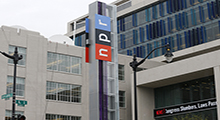
NPR’s headquarters in Washington, D.C.
In January, months after “Serial” rocketed to the top of the iTunes podcasting charts and ignited a conversation about the “Golden Age of Audio,” NPR was preparing to answer with a hit of its own.
The show had spent more than a year in development. For its launch, staffers used every bit of experience they’d gained about how to engineer a popular program: They cross-promoted previews of the show on podcasting staples like “This American Life” and “Radiolab,” coordinated a media campaign, even set aside a modest sum — about $1,500 — to buy Facebook ads promoting the show.
It paid off.
Since “Invisibilia” launched on Jan. 6, its episodes have been downloaded more than 33 million times, briefly eclipsing “Serial” on the iTunes charts. When NPR staffers saw the attention the show was getting from cross-promotion and other media mentions, they cancelled the ad campaign after spending about $400.
“It’s just been a huge force of nature and it’s been a tremendous validator for us of all these things we’ve learned,” said Eric Nuzum, vice president of programming at NPR.
The program’s popularity comes at a heady time for podcasters, when listeners, advertisers and technology have converged to create fertile ground for the medium to grow. Before and after “Serial” saw runaway success, two podcasting networks launched, Slate’s Panoply and Gimlet Media, the latter a project of former “This American Life” producer Alex Blumberg. Since then, BuzzFeed, The Associated Press and many others have gotten on board.
But for NPR, which has been in the podcasting game since 2005, the sudden attention was another indicator that its offerings had been gaining steam with listeners and advertisers for some time. The public radio network doubled its podcasting revenue in 2014, and is on track to double it again in 2015, said Bryan Moffett, interim president and CEO of National Public Media. The network has also seen monthly downloads for its podcast portfolio take off in recent years, increasing from 37.5 million in October 2013 to more than 90 million in March 2015, Nuzum said.
The key to this audience growth? A lot of pruning. Listeners who checked NPR’s podcast directory in October 2013 would have found a disorganized list of more than 100 different offerings there, Nuzum said. Even as the audience for the podcasts grew, there was no one in charge of the shows and little in the way of strategic direction.
“It was really hard to find things you were actually there to look for,” he said.
So, the network gradually trimmed its portfolio of podcasts down to 30, cutting out shows that didn’t fit in with a series of new guidelines. Podcasts that consisted primarily of excerpts from other shows were out. They ditched a lot of shows featuring roundups of stories about movies, or science, or international news. With a few exceptions, anything that wasn’t a “full experience” — a standalone podcast that didn’t need to borrow from other NPR offerings — was cut.
The next step was to bring a wider audience to this leaner list of shows. The network’s directory, which remains one of the top Google search results for “podcasts,” used to be a bad experience for listeners, who initially had to scroll through page after page to find what they were looking for, Nuzum said. The revised directory displays the slimmed-down list of podcasts prominently, with a simple category search replacing a “mix your own podcast” function on the old podcast landing page.
The other audience-building strategy that NPR learned is one that was used to great effect in the case of “Serial” and “Invisibilia.” Cross-promotion, the engineering of the so-called “Ira Glass bump,” has brought the network “millions and millions” of additional downloads, Nuzum said. “Invisibilia” is the most telling case. But there are other success stories, too. For several months, NPR had “Pop Culture Happy Hour,” “Ask Me Another,” “How to Do Everything,” “Snap Judgement,” and “Intelligence Squared” take turns having their respective hosts telling listeners to go check out the other podcasts, one at a time. The result? In all but one case, the podcasts saw a spike in downloads the week after they were promoted on the other shows.
The network repeated the experiment again, this time with eight or nine podcasts. After that, staffers divided NPR’s podcasts into four or five small groups with shows that relate to one another and instructed the hosts of those shows to promote the other podcasts in the group. Eventually, the plan is to move those groups around and try another round of cross-promotion.
“It’s a great case study in the power of focus,” Nuzum said.
Although advertisers have followed listeners to NPR’s podcasts, the shows won’t eclipse NPR’s larger streams of revenue anytime soon. While podcasting is among the network’s fastest-growing revenue sources, it is still nowhere close to the largest, Moffett said. He was reluctant to break down the dollar amounts specifically, but he did say that podcasting is currently a seven-figure business that the network is trying to grow into the mid-seven figures. Compared with NPR’s total corporate sponsorship revenue, which is a mid-eight figure business, that’s relatively small.
NPR is still interested in stoking advertiser interest, however. In late April, the network will hold a podcasting upfront in conjunction with WNYC and Chicago Public Media featuring the stars from their respective podcasts. The idea, Moffett says, is to pitch the larger advertising and marketing community on different podcasting offerings from public media outlets.
“When you look at the iTunes year recap for 2014 in podcasting, six of the top 10 most downloaded podcasts were from the three of us,” Moffett said. “I think that we at least feel that public radio, and particularly those three entities, have been a driving factor in podcasts for a very long time.”







Comments